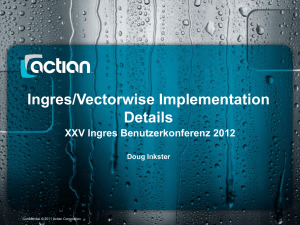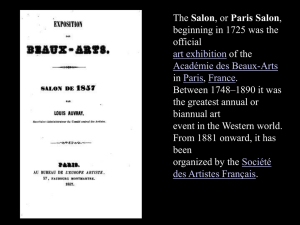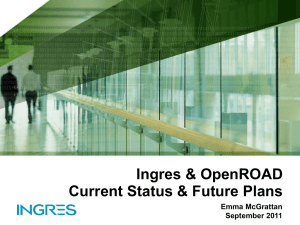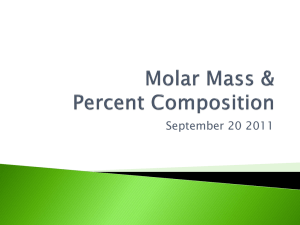VectorWise
advertisement
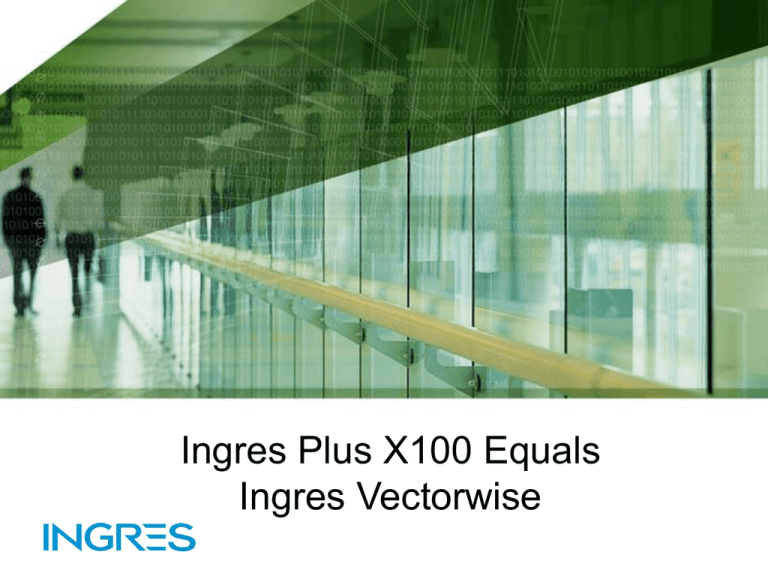
Ingres Plus X100 Equals
Ingres Vectorwise
Agenda
Why?
Introduction to Vectorwise
Groundwork
Vectorwise and OPF
Vectorwise and QEF
Names
X100 was the research project name
– “faster times 100”
VectorWise (or Ingres VectorWise) is the product
name
X100 or IVW or VW abbreviations are used internally
It's all pretty much interchangeable
Why Ingres?
Ingres – enterprise RDBMS
–Full functioned data base server
–User interfaces: SQL, embedded SQL, API, ODBC,
JDBC, etc.
–Application interfaces: OpenROAD, ABF, etc.
–Utilities: backup, restore, rollforward, etc.
–…
VectorWise – experimental RDBMS
–Very (very, very, …) fast
–But only QEF/DMF equivalent
Confidential — © 2009 Ingres Corporation
Slide 4
Why Ingres?
Developing “required” components would take many
years
Established sales force, customer base
Right sized company
Agreeable business arrangements
Confidential — © 2009 Ingres Corporation
Slide 5
What’s in VectorWise?
Column store data base
–Hybrid row store capability is coming
Internal catalog
–Store definitions of tables, columns, indexes, etc.
Relational algebra language interface
–Used for DDL and DML operations, transaction management
–Basis of Ingres interface
Various tools & utilities
–iivwinfo, iivwfastload, iivwstats, x100pp, x100profgraph,
x100_client
Confidential — © 2009 Ingres Corporation
Slide 6
VectorWise Algebra
Actual queries that go to VectorWise are recorded in
the VectorWise log – DML can be seen by using trace
point op207 (don’t forget to use x100pp)
Simple queries:
CreateTable, MinMaxIndex, Savepoint, Commit
DML:
Append, Update, Delete
Confidential — © 2009 Ingres Corporation
Slide 7
VectorWise Algebra
Retrievals – queries consist of nested operators, built
by the OPF cross compiler
–Project, Select, TopN, Window, Sort, Aggr, OrdAggr,
Mscan, MergeJoin1, HashJoin01, HashJoinN, CartProd
–“select sno, city from s where status > 50” generates:
Project(
Select(
Mscan(_s = ‘_s’, [‘_status’, ‘_city’, ‘_sno’]
), [‘est_card’ = ‘5’], >(_s._status, sint(‘50’))
), [‘est_card’ = ‘1’], [_s._sno, _s._city]
)
Confidential — © 2009 Ingres Corporation
Slide 8
VectorWise Algebra
One more “select r_name, n_name from region, nation where
r_regionkey = n_regionkey order by r_name” generates:
Sort (
Project (
HashJoin01 (
MScan ( _nation = '_nation', [ '_n_regionkey', '_n_name']
) [ 'est_card' = '25' ] , [ _nation._n_regionkey ],
MScan (_region = '_region', [ '_r_regionkey', '_r_name']
) [ 'est_card' = '5' ] , [ _region._r_regionkey ], 0
) [ 'est_card' = '25' ] , [_region._r_name, _nation._n_name]
),[_region._r_name]
) Confidential — © 2009 Ingres Corporation
Slide 9
VectorWise – Why is it so Fast?
Primarily a column store – much less data read from disk
Compression techniques highly tuned to modern
computer architectures (multi-level caching, etc.)
Lightweight indexing technique
Other column stores operate on re-constituted rows
VectorWise uses new and novel execution architecture
that retains column structure and processes vectors of
data at a time
–SIMD, CPU cache, …
Research is ongoing and there’s more to come!
Confidential — © 2009 Ingres Corporation
Slide 10
Implementation Goals
Minimize special X100-only syntax
Minimize effect on server facilities not directly
involved (e.g. SCF, DMF)
Localize changes to affected facilities as much as
possible
(Optimizer in particular) Write new algorithms in
such a way that Ingres tables could eventually take
advantage
Groundwork
Initial thought was to add X100 as a new built-in
Gateway, similar to IMA etc
– Presumably would cause minimal changes to QEF
– Would probably be too slow (every result row filtered
one at a time from GWF to DMF then QEF)
Better idea, add Vectorwise as a new table storage
type
– OPF will generate special plans for IVW tables
– Easy to do, minimal new syntax required
Ingres catalogs carry Vectorwise table definitions
Groundwork
Parser changes:
– WITH STRUCTURE=VECTORWISE
• Config default for IVW installations
• SET RESULT_STRUCTURE …
– Various checks to disallow VW tables in contexts
where they aren't supported (e.g. DB procedure)
– New “CALL VECTORWISE” statement to send nonSQL-related requests (e.g. combine)
– New statement types for VW DDL statements
• Especially for constraint operations
– New query-uses-VW-tables flag(s)
Groundwork
Front-end utilities changed to recognize VW table
types
– Some additional work required by VW restrictions,
such as create index only allowed on empty tables
Essentially no sequencer changes
– Minor change to recognize X100 interface facility
DMF changes to permit tables with no underlying
table file
DMF changes for backup/restore
RDF changes to support (hidden) VW join indexes
VectorWise & OPF
Parsing is “easy”, but why did we think OPF could
compile VectorWise queries?
Optimization is all about row sizes, cardinalities and the
comparison of different plans
optimizedb works on VectorWise tables and produces
good cardinality estimates
The optimizer architecture is designed to work for any
target database engine
Confidential — © 2009 Ingres Corporation
Slide 15
VectorWise & OPF - Changes
Functional dependencies
Dependence relationships can be derived from unique
constraints, referential relationships, joins, group by
Allows identification of DERIVED columns not needed for
duplicates elimination & grouping operations – very
important to VectorWise
Confidential — © 2009 Ingres Corporation
Slide 16
VectorWise & OPF - Functional Dependencies
select c_custkey, c_name, sum(l_extendedprice * (1 - l_discount)) as revenue,
c_address, c_phone, c_comment
from ...
group by c_custkey, c_name, c_phone, c_address, c_comment
generates:
Project (
As (
Aggr (
Project (
...
) [ 'est_card' = '56357' ] , [_TRSDM_1 = *(_lineitem._l_extendedprice,+( (_lineitem._l_discount), decimal('1'))), _customer._c_comment, _customer._c_address,
_customer._c_phone, _customer._c_name, _customer._c_custkey]
), [_customer._c_comment DERIVED, _customer._c_address DERIVED, _customer._c_phone
DERIVED, _customer._c_name DERIVED, _customer._c_custkey] , [_revenue_3 =
sum(_TRSDM_1)] , 5636
), __VT_3_0_2_1
), [_c_custkey_1 = __VT_3_0_2_1._c_custkey, _c_name_2 = __VT_3_0_2_1._c_name,
__VT_3_0_2_1._revenue_3, _c_address_4 = __VT_3_0_2_1._c_address, _c_phone_5 =
__VT_3_0_2_1._c_phone, _c_comment_6 = __VT_3_0_2_1._c_comment] )
Confidential — © 2009 Ingres Corporation
Slide 17
VectorWise & OPF - Changes
Clustering
Aggregation doesn’t need input sorted on GROUP BY,
just clustered
Indexing, joins, other aggregations have clustering
properties
OrdAggr() is much faster than Aggr()
Confidential — © 2009 Ingres Corporation
Slide 18
VectorWise & OPF - Changes
Referential relationships
OPF historically ignored referential relationships
Joins across referential relationships have additional
properties
– Cardinalities, clustering/functional dependencies
VectorWise join indexes enable very fast MergeJoin
New iirefrel catalog to track referential relationships
Confidential — © 2009 Ingres Corporation
Slide 19
VectorWise & OPF – Referential Relationships
“select r_name, n_name from region, nation where
r_regionkey = n_regionkey order by r_name” generates:
Sort (
Project (
MergeJoin1 (
MScan (_nation = '_nation', [ '_n_regionkey', '_n_name', '__jnation']
) [ 'clusterid' = '1' , 'est_card' = '25' ] , [ _nation.__jnation ],
MScan (_region = '_region', [ '_r_regionkey', '_r_name', '__tid__']
) [ 'clusterid' = '1' , 'est_card' = '5' ] , [ _region.__tid__ ]
) [ 'est_card' = '25' ] , [_region._r_name, _nation._n_name]
),[_region._r_name, _nation._n_name]
)
Confidential — © 2009 Ingres Corporation
Slide 20
VectorWise & OPF – Reuse Segments
VectorWise can cache partial results for later reuse in
same query
OPF searches for common table subexpressions
VectorWise materializes them once and caches them for
later reuse
Confidential — © 2009 Ingres Corporation
Slide 21
VectorWise & OPF – Reuse Segments
select s_acctbal, s_name, p_partkey, p_mfgr, s_address, s_phone, s_comment
from part, supplier, partsupp where p_partkey = ps_partkey and s_suppkey = ps_suppkey and ...
and ps_supplycost = ( select min(ps_supplycost) from partsupp, supplier where p_partkey = ps_partkey and
s_suppkey = ps_suppkey)
generates
Project (
HashJoin01 (
As (
IIREUSESQ6 =
Project (
HashJoin01 (
MergeJoin1 (
MScan (
_partsupp000 = '_partsupp', [ '_ps_suppkey', '_ps_partkey', '_ps_supplycost', '__jpartsupp'] ...
), __VT_6_1_3_1
), [ __VT_6_1_3_1._p_partkey, __VT_6_1_3_1._ps_supplycost ],
As (
Aggr (
As (
IIREUSESQ6, __VT_6_0_3_2 ...
Confidential — © 2009 Ingres Corporation
Slide 22
VectorWise & OPF – Cross Compiler
Optimizer compiles QEP
Code generator converts it to executable (by QEF) code
form
Native Ingres query plans are fairly simple
transformations from QEP
VectorWise query plans are algebra syntax built from
QEP
QEF sees trivial query plan with single action – the
VectorWise syntax
Confidential — © 2009 Ingres Corporation
Slide 23
VectorWise & OPF – Cross Compiler
Cross compiler analyzes QEP much like code generation
does for native Ingres queries
QEP nodes result in VectorWise operators
–ORIG nodes produce Mscan() operators
–Join nodes produce Merge/HashJoin() operators
–Etc.
Generates functions supported by VectorWise
– “not like” becomes “!(like(...”
Challenging issues of scope in name management
–Lots of “invented” table, column, partial result name
Confidential — © 2009 Ingres Corporation
Slide 24
Vectorwise and QEF
select t2.str,count(t1.i) from t1 join
t2
on t1.i=t2.i group by t2.str
The full QP tree in brief:
GET
/
| 0|
QP
/
HAGF
/
| 1|
HJN
/
\
| 2| | 3|
ORIG ORIG
The full QP tree in brief:
vs
X100Q
Vectorwise and QEF
New QEA_X100_QRY QP action header
Handles select, update, delete
X100 algebra text is sent to X100 server, reply rows
(if any) returned to the user in the usual QEF manner
– QEF arranges for X100 interface to materialize
rows directly into SCF buffers
REPEAT query parameters substituted as text into
the X100 algebra
Vectorwise and QEF
New action types for X100 create table, create/drop
constraint
New X100 control blocks attached to existing QEF
cb's for CREATE TABLE, COPY, INSERT
Little effect on existing QP nodes
– QEN_QP extended to understand QEA_X100_QRY
for VW → Ingres CTAS, VW scrollable cursors, future
mixed query support
Transaction interface (start, abort, commit)
– X100 done first as it's more likely to fail
COPY and INSERT
COPY uses Ingres COPY client side code but sends
rows to X100 rather than DMF
– No worker threads used
– VW COPY obeys constraints, may fail at end
Bulkload (APPEND) vs single row (INSERT)
– Both use X100 BinaryScan operator to read rows
coming from Ingres
– Append is used for COPY, INSERT/SELECT
– Insert is used for INSERT VALUES
Vectorwise DDL
DDL does Ingres catalog DDL first, then VW DDL
– Allows Ingres-style name checking, locking (sort of)
– DMF knows that VW tables have no disk file
Constraints implemented directly in X100 rather than
as system generated rules/DB procedures
– New iirefrel catalog updated for referential constraints
– Will someday be useful for Ingres constraints too
VW CREATE INDEX is really a MODIFY
X100 Interface
back/x100/x100 contains low level Vectorwise server
interface:
(X100) Server and session control
NetBuffer Ingres ↔ X100 protocol
Ingres ↔ X100 data type and null translation
X100 → E_VWxxxx error code translation
Generation of simple canned queries for some
operations
– e.g. generates Append(BinaryScan(...)) for COPY
X100 Interface
X100 Server runs as a separate process, one per
database
– Ingres session does not connect until a VW query is
issued
– X100 Server doesn't start until it's needed
– Once started, server persists until shutdown,
terminate request, or destroydb
– Active servers are tracked globally (in lock-log shared
memory) so dmfjsp can access them (this is new)
X100 Interface
Simple “NetBuffer” protocol talks to x100 server
– Send (text) X100 Algebra query to X100
• “password” trailer validates the sender
– Receive ack (after query successfully parsed)
– Receive or send rows (if select or insert)
• Receive-with-timeout to poll for FE interrupts
– Receive end-of-query
– Error message packet terminates query
Interrupt to X100 handled with VW syscall from a
transient connection
Futures
New iivwfastload
– Direct pipe from client to X100 server
– Special COPY variant will be created to handle X100
server checks, table permit validation, etc
– Maybe hook to regular COPY too???
Mixed Ingres/VW queries
– Mostly an optimizer problem
– Partition query into Ingres and VW parts
– Subquery results pushed into Ingres or VW temp
tables as needed
Futures
QEF bypass (blue sky?)
– Feed results directly to client or GCD
Apply new optimizer algorithms to Ingres queries
– Reuse, iirefrel, functional dependency analysis, etc
– Antijoins in QEF to reduce the use of Ingres Sejoins
Merge Ingres main and IVW (codev) code lines!
Questions?

